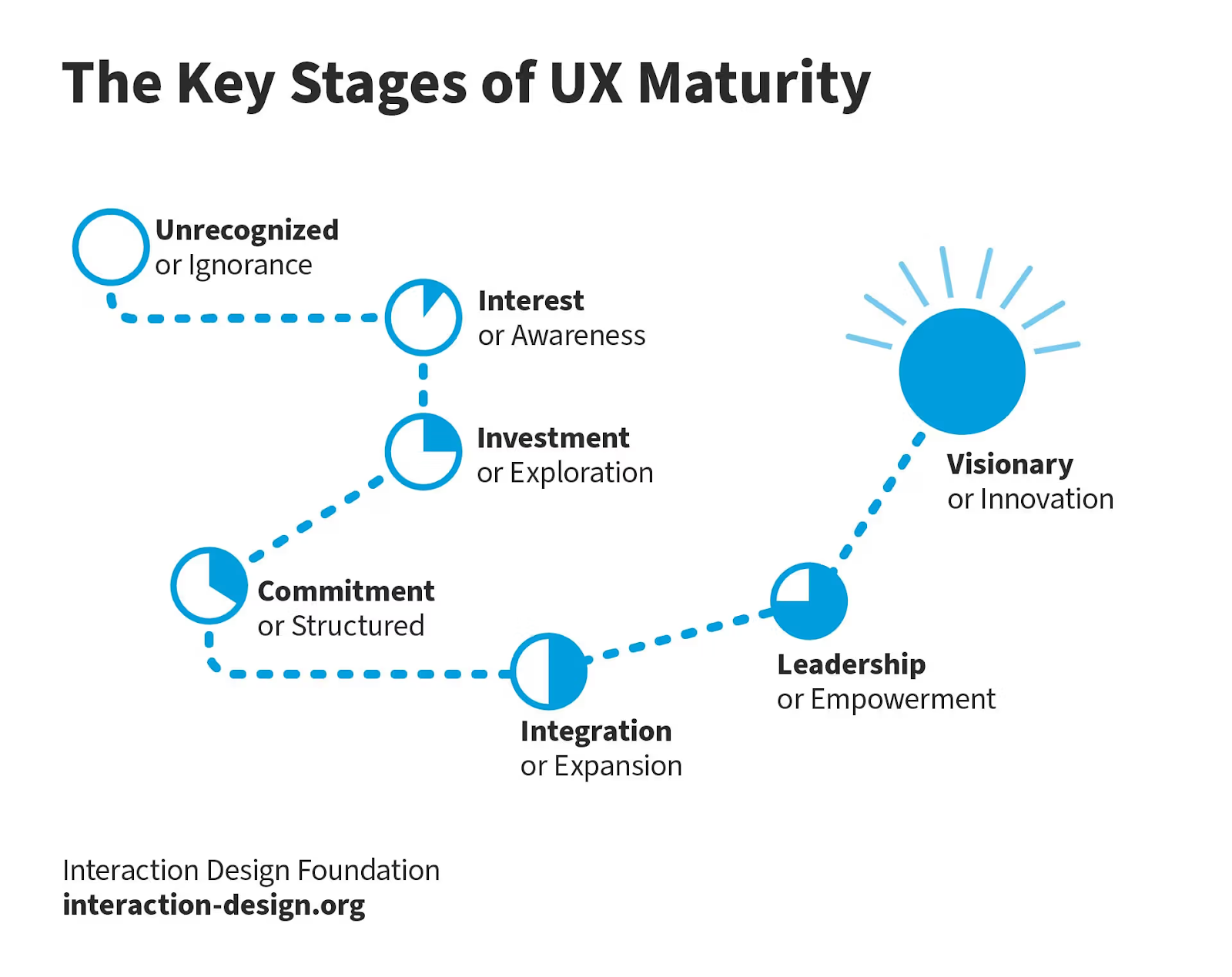
Why are online platforms so interesting that you want to always come back to them, while their rivals may provide the same service and have the most complex and tedious platform? The answer lies not just in functionality or design, but in a company’s level of UX maturity, which displays whether your software is user-friendly.
Companies with high UX maturity don’t just create convenient and pleasant products; they achieve tangible business results: increased conversions, customer loyalty, and a competitive edge. For instance, companies that invest in improving their customer experience often see substantial benefits, such as a 42% customer retention increase boose, and a 32% rise in cross-selling and up-selling opportunities.
Ready to learn how to elevate UX maturity and turn it into a business asset? Let Corpsoft Solutions experts help you improve your ux design process with this guide!
What is the UX Maturity?
This term refers to how well a company integrates user experience (UX) principles into its business processes and culture. It determines whether their UX efforts are systematic and user-centric.
To assess whether your online software fits the UX design lifecycle maturity, take a closer look at these 4 parameters below.
|
Parameter |
Low UX Maturity |
High UX Maturity |
| Processes |
UX activities are sporadic or nonexistent. All design decisions are based on pure assumptions without even minimal research. |
The developers and designers monitor user data to create the best user interface for them |
| Tools | There are almost no tools, as the team relies on subjective judgment | The company uses the latest UX tools, such as analytics platforms, heatmaps, and usability testing tools |
| Team Involvement | UX is considered the sole responsibility of designers, as “This is design and you are DESIGNER, so do something about it”. | Decision-makers finally understand that a user-friendly design is the result of cross-department collaboration: from developers to even copywriters |
| UX Culture | There is a lack of understanding of UX importance of UX at the strategic level. The project’s success is measured by aesthetics rather than impact on business metrics. | UX is deeply integrated into the company’s DNA and strategic planning, where UX research is a fundamental part of decision-making processes. |
UX development is a never-ending process, as users’ needs and vision of “intuitively clear and modern” software constantly change.
Why UX Maturity Is More Than Just a Design?
UX maturity significantly impacts a product’s survival and success. A well-developed UX strategy enhances user satisfaction and improves your SEO metrics, making your online product easier to find. There are 6 maturity stages, each of which makes your services even more user-friendly.
A great UX design offers a seamless onboarding process, intuitive navigation, and efficient transactions, leading to higher conversion rates. For instance, after implementing user research and design improvements, some companies have experienced up to 200% conversion rate increases.
A positive user experience encourages users to explore your software. It even lowers the burden on your support agents, since users independently navigate your platform.
Keep in mind that the quality of UX directly influences how users perceive a brand. A product that is difficult to use can tarnish a brand’s reputation, while a positive UX enhances brand image and fosters customer loyalty.
Investing in UX development is not just about creating aesthetic designs; it’s about embedding user-centric approaches as your core business principle.
How To Determine Your Current Stage?
Once you determine where exactly you are in the UX maturity scale, you’ll unlock the key to making your business even more lucrative. Self-assessments can also help you improve relationships with your clients.
Assessing your company’s position on the UX maturity scale is crucial to understanding your current and potential client relationships. The most straightforward approach to maturity analysis is to analyze the Self-Assessment UX Maturity Framework.
It will show your current strengths and what you should implement to improve your software. Let’s examine the UX maturity scale together!
Typical UX Maturity Self-Assessment Scale In 2025

As we said before, there are digital maturity stages, and since you are reading this article, you are already pretty high on this scale. The classic assessment model allocates businesses not only by the design, but also by the team’s intentions. Here are more details:
- Absent: There are no UX practices, and all decisions are made by intuition.
- Limited: There are some UX initiatives every now and then, but they are still unstructured. A part of the team tries to do user research but lacks access to professional tools.
- Emergent: The organization begins to recognize the value of UX, implementing more standardized processes. The company conducts user research from time to time, as they start to see the influence of a user-friendly interface on their ROI.
- Structured: UX is integrated into core processes. Product teams consistently base decisions on user research, and established UX design standards guide development, ensuring a more user-centered approach.
- Integrated: Finally, UX-research and user-friendly development become strategic. The organization makes most decisions based on whether changes benefit the end-user.
- User-Driven: UX is deeply embedded in the company culture, and ALL decisions are made while keeping the end-user in mind.
Progressing through these levels signifies an organization’s evolution from a lack of UX awareness to a culture where user experience is central to all operations and strategies.
Determining Your Design Maturity: Self-Assessment Cheat Sheet
Elevating your company’s UX maturity stages is a journey that never ends. Meanwhile, it’s crucial to determine where your company is now. That way, you can improve your productivity while saving money.
Level 1: Abstent
At the Absent level of the UX lifecycle, organizations lack focus on user experience; design decisions are made without considering user needs, often resulting in complex and unsatisfactory products.
All decisions are made by the “I just like it” principle. No one thinks about user friendliness, since your team looks only at the aesthetics. If you want to move further, conduct basic user research. Add Google Analytics and Hotjar to understand how users leverage your platform.
Level 2. Limited
If you find yourself at the Limited stage of the UX design process, you don’t need to be sad. At this stage, young companies start to acknowledge the importance of the user experience. They may not be systematic about it, but the team occasionally performs user tests.
Designers consider user needs without standardized methods, and research occurs sporadically, often influenced by individual enthusiasm rather than strategic planning. UX decisions are not consistently data-driven, and the value of UX may still be questioned by management.
To progress to the next stage, you must make UX research a standard practice for your business. Implement regular user research, such as usability testing, and develop initial UX guidelines covering your internal usability standards, typography, color schemes, and interaction patterns.
Educate your team on key UX principles, including product managers, developers, and designers. Integrate UX considerations into development cycles, ensuring designers contribute to aesthetics and functional planning. You can try more complex analytical tools like Mixpanel for user behavior insights, Maze for remote usability testing, and UserTesting for direct user feedback.
Level 3: Emerging (Формується UX)
At this stage of the UX maturity model, organizations finally recognize the importance of user experience. The efforts switch from “now and then and… maybe never” to rare but regular research like usability testing or user interviews.
Most of these efforts are still not so well-structured, but at least the team tries to do it. While some teams may see positive outcomes from these efforts, UX is not yet a central focus in decision-making, and its impact on business strategy remains limited.
At this stage, you also need to implement the design system that consists of:
- Pattern and Component Libraries: Collections of reusable UI elements like buttons, forms, and navigation bars.
- Style Guides: Documentation detailing brand colors, typography, spacing, and other visual elements.
- Design Languages: Coded components and brand languages that ensure a cohesive user experience.
- Documentation: Guidelines and best practices that facilitate consistent design and development processes.
Automate most of your efforts. There is no need for 24/7 manual monitoring, as in most cases, the automated and AI-based tools can simplify the mundane job aspects for most of your staff.
To advance to the next level, your team must establish frequent and standardized UX processes, such as mandatory usability testing before feature launches. You also need to foster in-depth collaboration among branches.
Level 4: Structured
If your UX assessment tells you your business is at the Structured level, congratulations! We know that you now understand that you are trying your best to make your product as user-friendly as possible.
In your case, UX research happens regularly, not just before big releases. Your teams rely on proven methods like Design Thinking and Human-Centered Design. Design systems and internal guidelines are in place, which help everyone stay on the same page. You know the importance of user feedback, which is why you constantly measure user interactions and ask your clients for feedback.
To move on to even higher steps of the design process, your company needs to go beyond just improving individual features. UX assessment becomes a core part of the company’s business strategy. You need to involve UX-related conversations in any work aspect to ensure that your business perfectly meets your clients’ needs.
The UX team should be present when big decisions are made. Not just to give feedback, but to shape the direction actively. The company should start investing in advanced tools like AI-powered analytics, emotional response tracking, etc.
At this level of UI UX assessment, it’s also crucial to connect UX results to business metrics. Run A/B tests to confirm which design performs better. Track things like retention, conversion, and user satisfaction.
Level 5: Integrated
At this stage, UX becomes a core part of your company. Every feature, every decision, every update is shaped by the needs of your users. So, each research study is aimed at improving user experience, even if it is an internal staff research study.
To go even higher in the ux maturity model, you should start treating the UX of your product as a competitive advantage, not just “it helps us to stay afloat”. You may start to invest in more advanced tools such as emotion analysis, AI-based research, and even biometric tracking. The UX team needs a seat at the big table, influencing business strategy, marketing campaigns, and even hiring.
Everyone in the company, from customer support to HR, needs to understand and support UX principles. When this culture is in place, UX becomes the foundation for everything the company does.
Level 6: Strategic
At the last level of the design maturity model, UX becomes the driving power for the whole business. It’s not a thing for IT-related departments, but more like a mindset that permeates every team and decision.
User needs shape long-term company goals. UX metrics are no longer isolated. Now, they’re deeply woven into financial indicators and business KPIs.
UX professionals influence executive decisions. Research insights don’t just affect what’s being built, but why it’s being built in the first place.
To sustain this level, you need to become “Harder, Better, Faster, Stronger”, or in other words, continuously evolve to new market and user demands. That way, you’ll become a trendsetter in your industry.
Wrapping Up
Determining your stage on the user experience maturity model is only the beginning of your journey. Once you find out the current stage, you unlock your path to success.
Each level has its “underwater stones” that are unnoticeable at the beginning. However, they have a direct impact on your future success. The higher the level of UX maturity, the more UX becomes a driver of business success.
As companies advance to higher levels of UX maturity, UX teams gain more influence in decision-making, and UX processes are integrated into every aspect of the company’s work, from product development to user interaction and strategic decisions at the executive level.
Want to reach a higher level of UX maturity relatively fast and with minimal losses along the way? Contact the Corpsoft Solutions team! We are experts in UX maturity, helping businesses in various niches to achieve their best! Our experts can help your team build a stable UX-oriented workflow, so you can focus on more artistic tasks.
Whether you need help with marketing, design, development, or if you’re looking for a fully managed project, we are here to help. Just reach out to us, and we’ll take care of everything efficiently!
Subscribe to our blog


